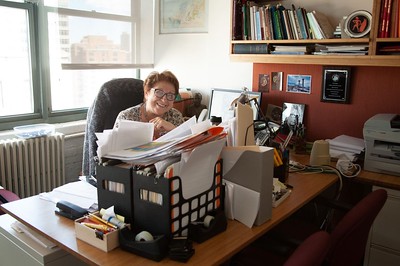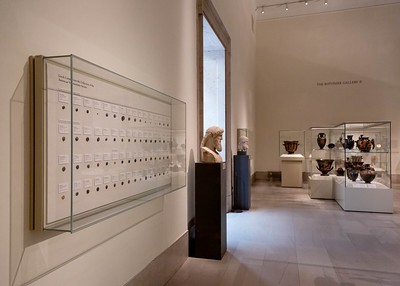
PREV ARTICLE
NEXT ARTICLE
FULL ISSUE
PREV FULL ISSUE
ANS COLLECTIONS MANAGER ELENA STOLYARIKAustin Andrews of the ANS recently published an interview in the Society's Pocket Change blog with Collections Manager Elena Stolyarik. Here's a short excerpt; see the complete article online. -Editor Dr. Elena Stolyarik, Collections Manager at the American Numismatic Society, has held nearly every single one of the Society's over 800,000 objects. As a critical member of the curatorial staff, the Collections Manager diligently maintains the Society's vast, encyclopedic holdings of coins and currency, medals and money—all behind the scenes. Dr. Stolyarik's background in museological, archaeological, and numismatic methods gives her a unique perspective on the purpose and function of the ANS. Prior to coming to the ANS in 1994, she led the Numismatic Department at the Odessa Archaeological Museum, excavated at Tyras on the Black Sea, and was a research associate at the University of Pennsylvania Museum of Archaeology and Anthropology. In an interview at the Society's headquarters in New York City, Dr. Stolyarik and Assistant Director Austin Goodwin Andrews discussed her work and the particularities of the Society and its holdings. Austin Goodwin Andrews: What is the role of the Collections Manager at a research institution like the ANS, where object care and curation are so intermingled? Elena Stolyarik: First of all, it means that you are a part of the professional team of one of the oldest museums and research institutions in the United States. The Society has been dedicated to researching numismatic objects and popularizing the field of numismatics since it was founded in 1858. Over the past 163 years, the Society obtained the objects in its collection from a range of sources, including from generous donations, bequests, and purchases. These and any new acquisitions should be properly maintained, preserved, and archived according to established museum practices and procedures. As the Collections Manager, I have several obligations. I register and manage documentation for all new museum objects, including accessioning and deaccessioning, cataloging, inventories, and other records. All of us in the curatorial department share responsibilities. We work as a team to ensure the collection is well cared for, documented, and made accessible to the public and for research. Because every one of us can replace each other when necessary, these are our mutual jobs. AGA: You're also involved with exhibitions and oversee all of the loans we make to other institutions. While the ANS regularly loans objects to major museums like the Metropolitan Museum of Art here in New York or the J. Paul Getty Museum in Los Angeles, we have loans to much smaller organizations, too, like the Bechtler House in rural North Carolina. What are some interesting examples of loans you've helped arrange? ES: This is also my job: to keep track of loans, to process new loans, to renew loans, for sending insurance and loan agreements. Along with the curatorial staff, I provide consultation services, help with selections and installations of our objects, and serve as courier to the borrowing institutions to accompany our loans. Today, we have over 380 objects on view in permanent, temporary, and traveling exhibitions. We don't have space for a big exposition here at the ANS, but we maintain our own Exhibition Hall with several cases on display to introduce our visitors to the history of numismatics. At the end of the year, the curatorial staff organizes a display with new annual acquisitions. When we had the original screw-press for the gold Bechtler dollars in a popular exhibit at the Federal Reserve, someone visiting from the Bechtler House saw it there and coordinated requesting the loan. This unique artifact became the centerpiece in their exhibition at the historic home of Christopher Bechtler in Rutherfordton, North Carolina. This is very important because, year after year, people can now visit this house and they can see real history: not only the coins, but they can see how these coins were produced. We had another interesting experience participating in an unusual exhibit organized by BVLGARI, known for its glamorous luxury products. This show, which was organized at their flagship store on Fifth Avenue, connected ancient Rome and the luxury brand since it was founded in Rome in 1884. It provided an opportunity to display some extraordinary objects from the ANS Roman Department, including a portrait coin of Julius Caesar and a remarkable example of a silver tetradrachm of Mark Antony and Cleopatra, among others. We have objects at some of the best museums in the US and abroad. The Met often has objects from the ANS for temporary exhibits—such as their successful World between Empires exhibit about art and identity in the ancient Middle East—but they also prominently display our numismatic objects in their permanent exhibits. I can think of many other interesting examples. The Jefferson Foundation at Monticello has displayed our silver Thomas Jefferson Indian Peace Medal since 1992 and War and Peace in Miniature: Medals from the American Numismatic Society was recently on temporary display at the Education Center at George Washington's Mount Vernon.
To read the complete article, see:
Wayne Homren, Editor The Numismatic Bibliomania Society is a non-profit organization promoting numismatic literature. See our web site at coinbooks.org. To submit items for publication in The E-Sylum, write to the Editor at this address: whomren@gmail.com To subscribe go to: https://my.binhost.com/lists/listinfo/esylum All Rights Reserved. NBS Home Page Contact the NBS webmaster 
|


